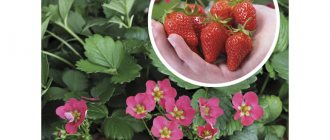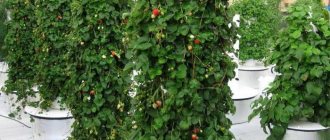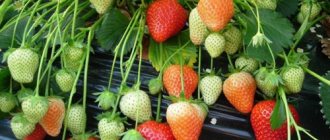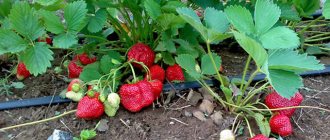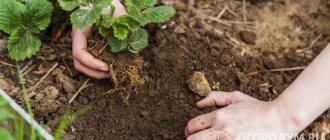Nowadays, buying a new product among the most diverse and exotic plants is not a problem. Garden strawberries (strawberries) are no exception. Or as it is called in some regions, “Victoria”. Many sellers offer the widest range of berry crops, including the latest achievements of world selection. True, not all of them actually sell what is indicated on the beautiful websites, often deliberately slipping an outright “re-grade” to the gullible buyer. But this is a question for a separate article and subsequent discussion.
Let's return to our topic. Newer and newer varieties and hybrids, with better characteristics in all respects, appear every year, and sometimes gardeners become afflicted with “new product mania,” buying and testing these elite plants on their plots. This is correct in its own way - all crops behave differently in different areas located in different regions with different soil types and weather conditions, often not fitting the clear description of the originators.
This can affect the taste, of course, the timing of ripening, the size of the berries, and the yield. Many who do not pass the dacha test are mercilessly uprooted, and a place is immediately prepared for the next new products. Well, those who “passed the exam” are registered as favorites and remain for permanent residence. And there are those specimens that grow for many years and constantly delight their owners, and people would never exchange them for others. One of these is our “Pole”, Mrs. Kama.
Main characteristics and description of the strawberry variety Kama
The bushes are not very tall; they are compact, but with powerful roots. The foliage is medium in size, slightly wrinkled, with pubescence on the reverse side, dark emerald in color. Peduncles are formed in medium numbers, drooping, strong, and grow below the level of foliage. Up to 5-7 ovaries are formed on each peduncle.
The flowers are produced in both male and female types, medium in size with white petals and a bright yellow center. Whiskers are formed in small quantities, but they are quite large.
Strawberry variety "KAMA" - video
Ripe fruits can be either cone-shaped or rounded-diamond-shaped with a clearly visible neck. The berries are lightly ribbed and have a characteristic shine. The skin can be from red to dark red or burgundy in color. The pulp is slightly compacted, very sweet. The seeds are yellow in color, pressed shallowly into the skin.
On a note!
The weight of ripe Kama strawberry fruits is up to 30 g, the first harvest can be much larger.
The highest yield and large berry size of this garden strawberry are observed in the first season after planting the seedlings. Over the next couple of seasons, the size of the berries begins to decrease, and the yield decreases. Therefore, it is recommended to replace the plantation of this strawberry once every 3-4 seasons.
The strawberry variety Kama received the highest rating from tasters - 5 points for the size, taste of the fruit and high yield.
The berries are versatile - they can be used fresh, added to desserts, decorated with confectionery, made into jam and marmalade, and frozen for the winter. When frozen, the berries do not lose their shape, taste and aroma.
Care Tips
Additional care is almost no different from other types of berries with minor nuances. The process of watering on an abundant scale, despite the resistance of strawberries to drought, should be carried out at least once a week. In cloudy and rainy weather, watering will not be required.
Strawberries of the Kama variety are most adapted to the drip irrigation method. The plant requires the same feeding as other varieties. For example, with abundant foliage growth, the berry lacks potassium. It can be easily replenished with ash or saltpeter fertilizer.
Productivity of the Kama variety
Since the Kama variety is remontant,
then the bushes can be harvested several times a season. The first wave of ripe fruits ripens early - they are harvested from the last ten days of May to the first ten days of June. The next harvests can be harvested approximately 2.5-3 weeks after the previous waves.
At least 1-1.2 kg of ripe produce is collected from each Kama bush
, which is a fairly high yield for remontant strawberries.
Collection and storage of garden strawberries
Before harvesting, stop watering the bushes abundantly. This is necessary so that the berries are not watery and can remain collected for more than 1-2 days. The fruits are removed with the stalk, with which they will be stored much longer than without it. Harvest in the morning, after the dew has subsided, or in the evening, when the sun's rays are no longer so scorching.
The peculiarity of Kama strawberries is that they have dense berries that do not crush during transportation. Therefore, it can be successfully transported and also stored for a long time. To do this, the berries are placed in boxes covered with paper. The fruits must be free of damage and dents. There is no need to wash them before storing them.
Note! Garden strawberries do not have the ability to ripen after picking the berries. Kama strawberries have a unique strawberry aroma and taste, which is why both gardeners and gourmets love them. In addition, housewives dry it, freeze it, and make compotes, jams, and preserves from it.
In addition, strawberries contain a large amount of useful substances that they can supply the body with throughout the year.
In addition, housewives dry it, freeze it, and make compotes, jams, and preserves from it. In addition, strawberries contain a large amount of useful substances that they can supply the body with throughout the year.
Kama strawberries have a unique strawberry aroma and taste, which is why both gardeners and gourmets love them. In addition, housewives dry it, freeze it, and make compotes, jams, and preserves from it. In addition, strawberries contain a large amount of useful substances that they can supply the body with throughout the year.
Each gardener analyzes many varieties when choosing a variety to cultivate. Before growing, you need to weigh all the pros and cons, and also become familiar with the individual characteristics of each species.
Experienced summer residents recommend paying attention to the Kama strawberry due to its many positive qualities and simple agricultural technology
This variety of garden strawberry was bred by breeders from Poland. The species was developed using the varieties “Cavalier” and “Zenga Zengana”. The result is a fruit crop that combines the positive qualities of two plants. The resulting fruits have universal application. The main feature in the description of the Kama strawberries is that the technically ripe fruits have a characteristic color, while the taste has sourness and the flesh is dense. It is best to transport the berries in this condition. This characteristic is especially important for those gardeners who grow strawberries for sale.
Diseases and pests
Kama strawberries are quite resistant to most diseases characteristic of this berry crop. But it is noted that the resistance of the variety to white and brown spotting is slightly below average. Therefore, it is recommended to carry out preventive treatment of strawberry plantations with a fungicide solution. The fungicide “Horus” is recognized as the most effective of them against these diseases.
The drug is used several times per season:
- Before the buds appear, the product is diluted in the following concentration: 6 g per bucket of water;
- when the ovaries appear, the solution is prepared as follows: 3 g of the drug is dissolved in a bucket of water;
- 7-12 days before harvesting ripe fruits, the concentration of the treatment solution should be as follows: 3 g of the drug is diluted in a bucket of water.
For 1 acre, no more than 5 liters of working solution of Horus fungicide is required.
The main pest that attacks Kama strawberry bushes is the strawberry mite. The most effective insecticidal drug in the fight against it is Actellik. The working solution for treating strawberry plantations is prepared as follows: 10 ml of the product is diluted in a bucket of water. For 10 m2, 1.5 liters of this solution is enough. To completely “deal” with these “harmful” bugs, a couple of treatments with an interval of 13-15 days are enough.
Important!
The last treatment of Kama strawberries against pests should be carried out 20-22 days before the expected collection of ripe berries.
Reviews
I grew Kama-72 for 10 years, only recently replaced it with Honey and Clery and I like the new varieties better. I consider Kama to be a strong average player - not bad, but nothing outstanding either.
“Kama” didn’t work for me, even young mustaches are affected by spotting. I don’t want to constantly spray the berries that you eat with systemic sprays.
Kama strawberries are a good choice for a gardener looking for an early variety with aromatic, tasty fruits. Kama is not suitable for large producers due to its average transportability and small berry size.
Pros and cons
The main advantages of the Kama strawberry variety include:
- The first harvest from this strawberry plantation can be harvested in the last ten days of May;
- remontability of the Kama variety - up to 3 harvests can be harvested per season;
- provided that a layer of mulch is added under the strawberry bushes, this variety can easily withstand periods of drought;
- mustaches are formed in limited quantities, so you do not have to remove them regularly;
- the fruits are large in size and have a beautiful presentation;
- excellent taste of Kama strawberries and the persistent aroma of ripe berries;
- good yield;
- the ability to grow the variety in greenhouse conditions, while obtaining very early harvests.
Excellent varieties of strawberries:
Strawberry Marshall Strawberry Albion Strawberry Malga
The main disadvantages of the variety include:
- the bushes are quite spreading, each producing a large number of leaves;
- each bush requires a lot of space to receive the required amount of nutrients;
- peduncles do not grow higher than the foliage;
- the Kama variety is characterized by low resistance to brown and white spotting;
- blooming buds do not tolerate cold temperatures below 0 degrees Celsius, therefore, during the period of budding and flowering, in case of threat
- In case of returning spring frosts, it is necessary to cover the beds with Kama strawberries with agrofibre.
a brief description of
Advantages of the variety
- early ripening;
- aromatic, fragrant berries;
- high productivity;
- extended fruiting periods.
Disadvantages of the variety
- low resistance to spotting;
- a small number of whiskers for reproduction;
- average fruit size.
Planting remontant strawberries Kama
Kama strawberries are one of the unpretentious and non-capricious varieties of this berry crop, so there is no special trouble with them when planting and further growing them. Almost all seedlings, if the planting rules are followed, take root, quickly acclimatize and grow. The variety is also undemanding in terms of care - it is enough to follow basic agrotechnical rules to obtain good harvests every year.
You should purchase strong, healthy seedlings of the Kama variety for planting - order them from a nursery or from trusted suppliers. Healthy seedlings have a strong and strong root system at least 15 cm long, without visible damage or traces of disease.
The foliage of such seedlings is a rich emerald color, also without traces of disease. Immediately before planting, the roots of the seedlings are inspected, shortened by several centimeters, and parts that are damaged or have signs of disease are also removed.
Planting remontant strawberries in the fall - video
Important!
The area for remontant Kama strawberries should be well illuminated by sunlight; in the shade, Kama strawberries will grow worse, and its berries will be small and sour.
You should also follow the rules of crop rotation. It is strictly forbidden to plant this berry crop after large plants that greatly deplete the soil - after sunflowers or Jerusalem artichokes.
The best predecessors for strawberries will be plants from the family of cruciferous plants, legumes and green crops, onions or garlic. You can plant it after tomatoes or cucumbers, but it is not advisable.
Stages of planting Kama strawberries:
- The soil must be fertile and loose enough to freely allow oxygen and moisture to pass through to the root system.
- Before planting strawberry seedlings, humus and wood ash are added to the soil, then the soil is dug up and loosened.
- Immediately before planting, the roots of the seedlings need to be dipped in a weak solution of potassium permanganate to disinfect, then placed in the holes.
- The roots are carefully straightened along the diameter of the hole, the top is filled with soil and compacted.
- Then make abundant watering.
- After watering, the soil is loosened again and covered with a layer of mulch.
It is better to plant the Kama strawberry variety in rows. In this case, the distance between neighboring plants should be about 0.4-0.5 m, and the row spacing should be 0.6-0.8 m. The bushes should not be planted more densely, otherwise it will be difficult for the grown plants to receive adequate nutrition from the soil.
Getting ready to land
The site for planting Kama must be prepared in advance. First, the soil is cleared of weeds. If there are a lot of weeds, you can use selective herbicides, for example, Lontrel. It is not recommended to use continuous action preparations; they take a long time to decompose and therefore can harm the strawberries themselves. After treatment, the area is plowed or dug to a depth of at least 30 cm.
After plowing, but before harrowing, fertilizers are applied to the soil. You will need rotted manure (a bucket per m2), superphosphate (0.1 kg per m2), potassium sulfate (0.12 kg per m2). Mineral fertilizers can be replaced with wood ash (0.15-0.2 kg per m2). After application, mandatory sealing is carried out. In a large area, you can use a cultivator for this; in a small garden bed, a regular rake will suffice.
Clay soils are loosened with sand, sandy soils are fertilized with double rates of fertilizers. If the site is located in a lowland, then it is better to form high beds; in any case, groundwater should be located below 1.0 m from the soil surface.
After plowing and before planting strawberries, it is advisable to wait at least 2 weeks. During this time, the soil will settle, which will avoid exposing the root system after planting.
Further care for Kama strawberries
Young plants should be watered daily until complete acclimatization, or at least every other day.
When the plants take root, reduce the amount of watering. But you need to know - provided the soil is mulched after watering, Kama strawberries can withstand long periods of drought. If mulching is not carried out, then in hot weather the strawberry plantation will have to be watered frequently, and after each addition of moisture the soil should be loosened to break up the crust that appears on the surface.
REPAIR STRAWBERRY!! CARE FEATURES - video
The harvest of ripening Kama strawberries is collected regularly to allow new fruits to ripen. After the berries turn red, they need to be given a couple more days to fully ripen.
Advice!
Wooden planks or slate are placed under drooping flower stalks with ripening fruits to prevent rotting of the fruits.
If slugs or grape snails appear on the site, a layer of pine needles is poured around the strawberry bushes, which will repel these pests from the ripening berries.
Feeding the berry garden
This strawberry variety is remontant; to obtain several harvests per season, the plants require regular fertilizing. Humus and ash are used as fertilizers, which are a source of many minerals, in particular potassium. But you can also use complex mineral fertilizer as a top dressing.
For the first time, you should apply fertilizer to Kama garden strawberries before budding begins.
. During the same period, preventive treatment of the strawberry plantation against pests (weevils or strawberry mites) is carried out, and the bushes should also be sprayed with a fungicide solution against various spots.
Preparing for winter
When preparing a strawberry plantation for the winter, the beds are covered with spruce branches, straw or fallen leaves. With the onset of frost, the strawberry bushes are covered with non-woven material.
With the onset of spring, the shelter must be removed.
How to prepare strawberries for winter - video
Strawberry propagation
To get a stable, rich harvest of berries, you need to periodically replace old seedlings with new ones. This is done once every 4-5 years. If there are more bushes in the garden bed, the quality of the harvest is significantly reduced. The berries become small, losing their excellent taste. The easiest and most common way to propagate a plant is to use tendrils. For this purpose, mother bushes are left on the site, which are grown for seedlings, not fruits.
Mother bushes must be young. The best age is 1 year, the maximum is 2 years. For reproduction, use the largest whiskers.
Old, fruit-bearing strawberries should be replaced with new ones no later than after 4-5 years. Keeping it longer is unprofitable - the berries become very small, their number decreases, and the yield drops sharply. For breeding, you can take mustaches from your bushes.
Strawberry Kama: reviews from those who planted the variety
Ira, 40 years old, Perm region: I have been growing this variety of strawberries in my garden for several seasons. I would like to note that Kama fruits begin to ripen at the end of May, and fruiting continues throughout the season, since Kama strawberries are a remontant variety. The largest berries ripen in the spring; subsequent fruits are not so large, but with excellent taste and aroma. I recommend Kama strawberries to all gardeners.
Olga, 60 years old, Stavropol region: In our region, Kama strawberries can be grown without shelter for the winter, since we practically never have frosts. True, in hot weather it needs to be watered often and the soil mulched, otherwise the berries will dry out. I like the fact that the Kama variety is remontant, so the berries can be picked throughout the summer.
Natalya, 30 years old, Labinsk: I have been growing strawberries for a long time, and I grow them for further sale. Recently, I have been growing the Kama strawberry variety - early ripening, remontant and high-yielding. I planted a couple of beds in a greenhouse, so I harvest my first strawberry harvest in mid-April - the harvested fruits are sold out very quickly, as the berries are tasty, sweet and aromatic.
Kama strawberries are one of the best remontant varieties that can be grown not only in garden beds, but also in greenhouses, thereby obtaining super early harvests.
Since this variety has a fairly high yield, and the berries tolerate transportation well at different distances, many gardeners grow the variety for further sale. Kama strawberries are also often grown on an industrial scale.
Recently also searched:
The most common mistakes in care
The Kama variety, although considered one of the easiest to care for, requires knowledge of the basics and mistakes of beginners. It is novice gardeners who make a number of typical mistakes in the care and maintenance of strawberries.
- If seedlings are not disinfected in time, you can attract not only the listed pests, but also additional pests.
- Lack of measuring soil acidity before planting berries.
- If the frosts in winter promise to be too severe, you should take care of additional cover for the strawberries.
- Despite the fact that Kama strawberries easily tolerate drought, the lack of timely, abundant watering leads to drying of the root system.
As you can see, the advice is simple and clear. But it is with this kind of care that “Kama” will give the best harvest.
How to deal with strawberry mite
Most often, the strawberry mite ends up in an area with infected planting material. And it spreads throughout plantings through clothing, shoes, tools, and through the mustache when the leaves touch. The mite reproduces on strawberry bushes in warm, humid weather. If it is exposed to direct sunlight, it quickly dies due to dehydration. Therefore, parasites are located on the underside of young leaves and under plants in the soil.
Signs of the presence of mites on plants:
- The bushes are underdeveloped.
- The leaves are small, twisted, wrinkled, strongly corrugated.
- Yellowish tint on leaves.
- There is a silvery coating on the underside of the leaves.
- The berries are drying out.
- The bushes are freezing.
Compliance with crop rotation is a very important and effective measure in the fight against strawberry mites: strawberries can be planted in their original place no earlier than 4 years later. Plant debris should be removed and weeds destroyed. It is necessary to loosen the soil more often, hill up strawberry bushes, and fertilize on time.
In early spring, when the ground is completely dry, collect all last year's leaves and all plant debris from the strawberry beds and burn them. After this, you need to pour half a liter of hot water (80 degrees) under each strawberry bush, hill up, feed and water the plants. During the growth of leaves, before flowering and after the formation of berries, they can be treated with a 70% solution of colloidal sulfur. Treatments are carried out every two weeks. If strawberries are severely damaged by mites, before the growing season begins, spray the beds with 3% Bordeaux mixture.
You can also use an infusion of onion peels or a decoction of garlic, covering the plants with plastic wrap after the procedure. Strawberries can be treated with pesticides only after harvesting. If strawberries are severely affected by mites after harvesting, it is necessary to mow and destroy all the leaves, water the plants abundantly and feed them with basic mineral fertilizers. You can treat with karbofos.




